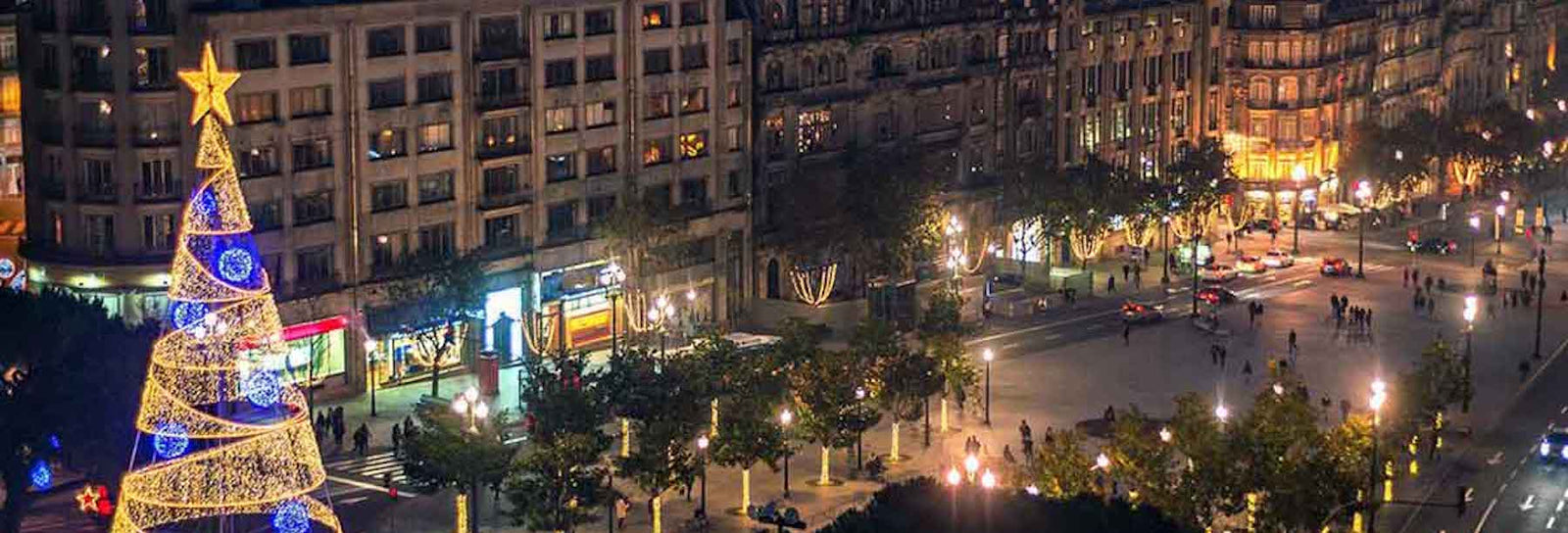Are you going to Portugal for the holidays or do you want to bring back some of the traditions of this beautiful country for Christmas? You're right, the Portuguese are great lovers of Christmas and leave nothing to chance for this special holiday.
From the north to the south of the country, traditions differ and everyone brings home rituals that are more or less ancient, in memory of their heritage. "Presépios", "Madeiros de Natal", "Missa do galo", and many others.
"Christmas" in Portuguese is called "Natal". Christmas celebrations in Portugal start to be prepared as soon as All Saints' Day is over. It is a highly anticipated moment in the year, both for children and adults.
In this blog post we tell you everything you need to know about Christmas traditions in Portugal.
Christmas lights
Just over a month before Christmas, cities light up. The inauguration of the Christmas lights in Lisbon usually takes place around November 15th.
It is an opportunity to marvel at the decorations placed in the streets and the trees, each one higher than the next, erected by the municipalities.
Today, in an effort to respect nature, natural trees have almost disappeared from Portuguese cities and are replaced by steel structures.

Pastry shop windows
The end of November is also the time when the windows of bakeries and pastry shops are filled with the famous 13 Christmas desserts. Bolo Rei, Bolo da Rainha, Pudim de Ovos, Baba de Camelo, Bola de Berlim... are already available.

If you want to make these desserts yourself, take advantage of our blog post, we have collected them. Click on the picture below.
Christmas Nativity Scenes
This is also the time when parishes or municipalities put up the famous Portuguese nativity scenes called "Presépios".
In Portugal, the cot is set up at the beginning of Advent, without the figure of the baby Jesus, which is only placed on Christmas Eve. Then the cot is taken down on the day of the Three Kings.
The tradition of the cot is still very present in Portuguese homes and artists are still inspired by it to create iconoclastic works like Julia Côta.

But in Portugal there are places that take nativity scenes to a whole new level. The cot in Vila Real de Santo António breaks its own record every year.
In the last edition, the cot had more than 5,600 figures, laid out on 20 tons of sand, 4 tons of stone, 3 tons of cork on a surface of 230 m², which required more than 2,500 hours of work.

Christmas markets
In mid-November, the cities light up and the first Christmas markets open with stalls full of handicrafts. If you want to know more about the most beautiful Christmas markets in Lisbon and Porto, check out our dedicated blog post or click on the photo below.

Christmas trees
As for the Christmas tree "Árvore de Natal" or "Pinheiro", it has not been part of the Portuguese tradition for very long and it is not necessarily adopted in all homes.
In Lisbon, it is more likely to be the pine tree that is used as a Christmas tree. Less bushy and less majestic than its cousin, it is one of the most widespread trees in Portugal and therefore easily available for sale.
In the capital and in Porto, every year, it is the firemen who sell Christmas trees. The "Pinheiro Bombeiro" (firemen's tree) is made by pruning the surrounding forests. This pruning is done annually in winter to maintain the forests and prevent summer fires.

A Árvore e o seu Zingamocho - Luisa Paixão collection
Although the Christmas tree is not the oldest custom in Portugal, the city of Viana do Castelo, in the north of Portugal, nevertheless makes a point of displaying the largest natural Christmas tree in Europe every year.
Similarly, in Guimarães, a procession traditionally takes place on 29 November to erect the Christmas tree in the central square, cut down at dawn.

Christmas Eve
Christmas Eve is called "Consoada" in Portuguese. The traditions are similar to those found in most places where Christmas is celebrated.

It was customary in the Catholic religion to fast on 24 December until the evening. Although this tradition has been lost over time, in Portugal Christmas Eve dinner is very simple.
The meal consists of cod served with potatoes and cabbage. The table is nicely decorated with candles and small typical Christmas decorations.
Midnight mass
After the meal, the Midnight Mass, the "Missa do Galo" (Rooster Mass) is held.
After the mass, in the north and centre of Portugal, large bonfires are lit in front of the church or in the central square of the town. These fires are called "Madeiros de Natal" or "Fogueiras do Galo".
This is a very old tradition of pagan origin, which has spread to certain regions of Europe. In south of France, this custom is also known as "Cacho fio".

Christmas gifts
After the mass, the families return to their homes where they enjoy the famous 13 desserts, a reminder of the 12 apostles and Jesus at the Last Supper.
In the meantime, the "Menino Jesus" (Little Jesus) has brought the Christmas presents to the dinner table. The gifts are then exchanged around a table full of joy.

Christmas dinner
On Christmas Day, December 25, the family gathers again at the Christmas table. This time, the dishes are hearty and elaborate. The dishes include oven-roasted kid "cabrito assado", "Leitão assado", roast suckling pig or turkey stuffed with chestnuts.

If you would like to discover the main recipes for Christmas dishes in Portugal, see our blog post dedicated to them.
Days after Christmas
In the days that follow, the Portuguese houses remain open to welcome all distant family and friends. It is customary to leave a table always covered with the 13 Portuguese desserts to welcome visitors.


